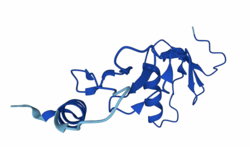Chemistry:U24-ctenitoxin-Pn1a
U24-ctenitoxin-Pn1a (or U24-CNTX-Pn1a) is a neurotoxin that is naturally found in the venom of Latrodectus geometricus (L.geometricus). It reduces the inactivation of insect voltage-gated sodium channels. It is also thought to be a cysteine proteinase inhibitor.
Etymology
The term ‘ctenitoxin’ in U24-ctenitoxin-Pn1a refers to toxins found in the venom of spiders from the Ctenidae family. ‘Pn’ is an acronym for Phoneutria nigriventer referring to the genus and species of the animal it was first isolated from. An alternative name for U24-ctenitoxin-Pn1a is “Venom protein PN16C3”. [1]
Source
U24-ctenitoxin-Pn1a is naturally found in the venom of Latrodectus geometricus, often referred to as the brown widow spider or brown button spider. The spider genus Latrodectus is found worldwide in pantropical and subtropical regions and is considered one of the most dangerous spider genera to humans and animals. Its venom contains latrotoxins, which are the main neurotoxins in the venom.[2]
Chemistry
Structure
U24-ctenitoxin-Pn1a is a 128 amino acid protein.[1] The amino acid sequence of the mature protein is:[1]
1 ARPKSDCEKH RESTEKTGTI MKLIPKCKEN SDYEELQCYE DSKFCVCYDK 50 51 KGHAASPIST KVKECGCYLK QKERKDSGRE SAIIPQCEED GKWAKKQLWE 100 101 FNKSCWCVDE KGEQVGKIHH DCDSLKCE 128
The molecular mass of U24-ctenitoxin-Pn1a is 14,778 Da.[1]
Family
U24-ctenitoxin-Pn1a belongs to the ctenitoxin family. Ctenitoxins consist of two repeats of thyroglobulin type I domain (Thyroglobulin type-1 1 and Thyroglobulin type-1 2) and a signal peptide. Based on the presence of the thyroglobulin domains, U24-ctenitoxin-Pn1a and other members of ctenitoxin family, are thought to inhibit the activity of cysteine proteinases.[1][2] Ctenitoxins, in general, also inhibit BgNav as well as the arachnid channel of Varroa destructor (VdNav1).[2][3]
Target and molecular mechanism
U24-ctenitoxin-Pn1a, purified from L.geometricus venom, reduces the inactivation of the insect voltage-gated sodium channels of Blatella germanica (BgNav) and Drosophila melanogaster (DmNav) expressed in Xenopus laevis oocytes.[2]
Toxicity
The neurotoxic peptides of the L.geometricus venom target the voltage-gated ion channels of both vertebrates and invertebrates. The effect of U24-ctenitoxin-Pn1a is in line with the effect of another toxin from the ctenitoxin family, PnTx2-1 (δ-Ctenitoxin-Pn1a). Both of these toxins slow down the inactivation of insect voltage-gated sodium channels; this may lead to paralysis or mortality of the insects.[2][3]
Therapeutic use
In general, since spider toxins influence the functioning of the nervous system, they are examined as a possible influence for therapeutic leads or bioinsecticides. The function of U24-ctenitoxin-Pn1a on altering ion channel activity has indicated that it can be viewed as a source for bioinsecticidal peptides.[2]
References
- ↑ 1.0 1.1 1.2 1.3 1.4 Richardson, M.; Pimenta, A.M.C.; Bernquerer, M.P.; Santoro, M.M; Beirao, P.S.L.; Lima, M.E.; Figueiredo, S.G.; Bloch Jr., C. et al. (2006). "Comparison of the partial proteomes of the venoms of Brazilian spiders of the genus Phoneutria" (in en). Comparative Biochemistry and Physiology Part C: Toxicology & Pharmacology 142 (3–4): 173–187. doi:10.1016/j.cbpc.2005.09.010. PMID 16278100.
- ↑ 2.0 2.1 2.2 2.3 2.4 2.5 Khamtorn, Pornsawan; Peigneur, Steve; Amorim, Fernanda Gobbi; Quinton, Loïc; Tytgat, Jan; Daduang, Sakda (January 2022). "De Novo Transcriptome Analysis of the Venom of Latrodectus geometricus with the Discovery of an Insect-Selective Na Channel Modulator" (in en). Molecules 27 (1): 47. doi:10.3390/molecules27010047. ISSN 1420-3049. PMID 35011282.
- ↑ 3.0 3.1 Peigneur, Steve; Paiva, Ana Luiza B.; Cordeiro, Marta N.; Borges, Márcia H.; Diniz, Marcelo R. V.; De Lima, Maria Elena; Tytgat, Jan (September 2018). "Phoneutria nigriventer Spider Toxin PnTx2-1 (δ-Ctenitoxin-Pn1a) Is a Modulator of Sodium Channel Gating" (in en). Toxins 10 (9): 337. doi:10.3390/toxins10090337. ISSN 2072-6651. PMID 30134593.
External links
 |


